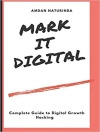The days of the image brands are over, and ‘new
marketing’ has gone mainstream. The world’s biggest
companies are pursuing a post-advertising strategy, moving away
from advertising and investing in leading edge alternatives. In the
vanguard of the revolution has been John Grant, co-founder of the
legendary agency St. Luke’s and author of The New
Marketing Manifesto, whose radical thinking has informed a
generation.
Now Grant is set to stun the industry again. In The Brand
Innovation Manifesto, he redefines the nature of brands,
showing why old models and scales no longer work and revealing that
the key to success today is impacting people’s lifestyles
(think Starbucks, i Pod and e Bay). At the heart of the book is the
concept of the ‘brand molecule’ to which new cultural
ideas can be constantly added to keep pace with change. Cataloguing
32 classes of idea, Grant presents a practical approach to mixing
and matching them within your own market to develop new brand ideas
– and new ideas for existing brands.
Inhoudsopgave
Acknowledgements.
Introduction.
SECTION I: BRAND THEORY REVISITED.
1 Challenges to the Old Model of Branding.
1.1 From Ad Idea to Media-Neutral Idea.
1.2 The Old School.
1.3 Protestant vs Catholic: The Battle for Brand Theory.
Summary of Chapter 1.
2 A New Theory of Branding.
2.1 What Is a Brand?
2.2 Brand as Strategic Cultural Idea.
2.3 Brand as a Cluster of Cultural Ideas.
2.4 The Brand Innovation Imperative.
2.5 Hybrid Vigour: Brand Partnerships, Feuds, Leaps and
Properties.
2.6 The Equivalence of Brand Creation and Brand
Communication.
2.7 A Shift from Targeting an Audience to Adoption.
2.8 Establishing New Lifestyles.
Summary of Chapter 2.
3 The Trouble with Trends.
3.1 The Difference between Cultural Trends and STEPs.
3.2 Real Trends.
3.3 Made-up Trends.
Summary of Chapter 3.
4 Strategy: Finding a Cultural Logic.
4.1 Problem Finding.
4.2 Finding a Third Way.
4.3 A Bigger Context or Market.
4.4 Outside-In Thinking.
4.5 Brand Archaeology.
4.6 Brand Renaissance.
4.7 What Is the Other Side of the Story?
4.8 Strategy as Scripting.
4.9 What Is Lacking?
4.10 The Cultural RNA.
4.11 What Are We Here to Do?
4.12 Busting the Tradeoff in Your Market.
4.13 Model a Distant Parallel.
4.14 Information Saturation.
4.15 Deconstruction, Reconstruction.
4.16 Demolish the ‘Ad in Your Head’.
4.17 Rekindle Your Curiosity.
4.18 Bringing the Strategy to a Point of Focus.
Summary of Chapter 4.
SECTION II: A TYPOLOGY OF BRAND IDEAS.
Building Your Molecule: 32 Brand Elements.
Chapter Strcture.
A Periodic Table for Brand Ideas.
1 New Traditions.
1A Habit Ideas.
1B Spectacular Ideas.
1C Leadership Ideas.
1D Organisation Ideas.
2 Belief Systems.
2A Cognitive Ideas.
2B Appreciation Ideas.
2C Faith Ideas.
2D Atlas Ideas.
3 Time.
3A Regressive Ideas.
3B Now Ideas.
3C Nostalgia Ideas.
3D Calendar Ideas.
4 Herd Instincts.
4A Initiation Ideas.
4B Crowd Ideas.
4C Clan Ideas.
4D Craze Ideas.
5 Connecting.
5A Co-authored Ideas.
5B Socialising Ideas.
5C Cooperative Ideas.
5D Localised Ideas.
6 Luxury.
6A Concierge Ideas.
6B Plenty Ideas.
6C Exclusive Ideas.
6D Exotic Ideas.
7 Provocative.
7A Erotic Ideas.
7B Cathartic Ideas.
7C Scandal Ideas.
7D Radical Ideas.
8 Control.
8A Personalised Ideas.
8B In-Control Ideas.
8C Competition Ideas.
8D Grading Ideas.
SECTION III: DEVELOPING BRAND STRATEGIES.
Developing New Brand Ideas in Practice.
Organised Chaos vs Corporate Constipation.
Using the 32 Cultural Ideas: Reframing.
Example: Let’s Kill Lynx.
Logical Conclusions.
References.
Index.
Over de auteur
John Grant co-founded the groundbreaking London advertising agency St Luke’s, and is now a marketing consultant with clients including IKEA, the Ministry of Sound, Diageo and Coca Cola. He is the author of The New Marketing Manifesto (Orion) which was selected as one of the top 10 business books of 1999 by Amazon, and of After Image (Profile), an industry bestseller. He is known for radical thinking and the industry will be eager to hear and adopt his latest ideas.












